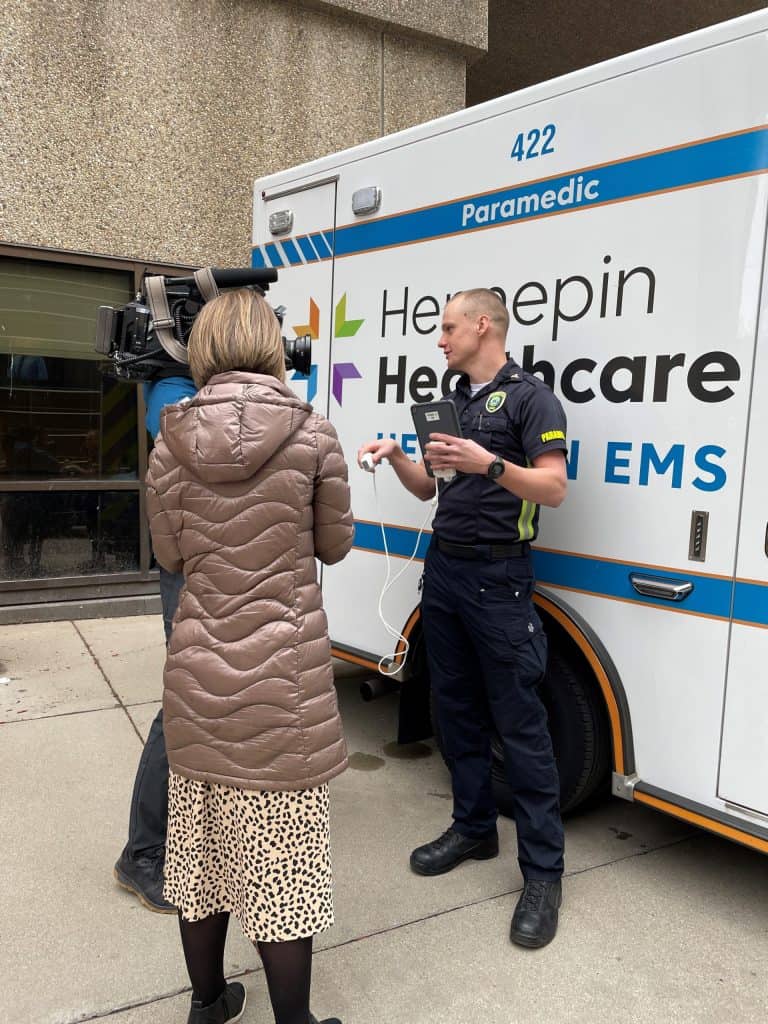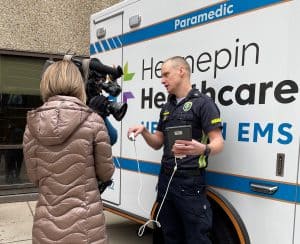Advanced paramedic training adds second chance at life for retired math teacher

 The numbers never get old for a retired math teacher Daniel Bowler from Benilde-St. Margaret’s. That’s why he continues to work at school where he’s the math league coach and helps others figure out problems – and where he ran into a problem of his own on March 15, 2022.
The numbers never get old for a retired math teacher Daniel Bowler from Benilde-St. Margaret’s. That’s why he continues to work at school where he’s the math league coach and helps others figure out problems – and where he ran into a problem of his own on March 15, 2022.
“We were having a pizza party event and I went to the office to pick up the pizzas like I always do,” he said. “I suddenly felt short of breath and dizzy – and I fell and hit my head.”
A student saw him fall and told someone to call 911. Hennepin EMS was immediately en route to care for a patient who had experienced head trauma from a fall.
Paramedics assessed the patient and ended up performing a diagnostic ultrasound of his chest. This indicated the presence of a pulmonary embolism (blood clot) in his lung – something several members of Hennepin EMS paramedics are highly trained to detect as part of a “P3 Program” but certainly not the original reason for the call.
“Upon arrival, it was more complicated than a fall,” describes Hennepin EMS paramedic Seth Bravinder. “Mr. Bowler had passed out, which raised the concern for something more than a simple trip and fall. Many different things can cause a person to pass out, and ultrasound can provide a great amount of information in a matter of seconds. When the ultrasound findings suggested PE, we knew he had to get to definitive care fast.”
Even though another hospital was nearby, it was recommended that he be brought immediately to HCMC – a Level I Trauma Center – for this type of emergency care.
“I thank God paramedics had the foresight to bring me to HCMC. When I arrived, an entire team was waiting for me,” said Daniel, who was discharged after spending only a few days in the hospital.
Daniel would have died without the quick response from everyone involved, including the lifesaving diagnostic technology available in Hennepin EMS ambulances and the advanced training paramedics receive. In this case, paramedics also gave the patient the appropriate fluids and medications before he arrived at the hospital to optimize his care, ultimately saving his life.
“Ultrasound is being done for more and more indications,” explains emergency physician Dr. Aaron Robinson. “We’re actively training up paramedics to use it for trauma and medical emergencies – as exemplified in this case. Ultrasound can be used to rapidly detect pathology such as internal bleeding, lung injuries, cardiac problems, and many more.” The P3 Paramedics go through extensive training to learn ultrasound, including hands-on sessions and time spent in the Hennepin County Medical Center Emergency Department with Hennepin EM and EMS Physicians. Most importantly, all ultrasound images obtained are securely saved, which allows EMS Medical Direction to review the images for quality assurance and continuing education.
Just a few days after Paramedics Seth Bravinder and Derek Smith saved Mr. Bowler’s life, Hennepin EMS Paramedics Dave Blizard and Josh Beck diagnosed severe internal bleeding with prehospital ultrasound on a patient which resulted in immediate transport and ultimately another life saved.
Dr. Robinson was one of the team members instrumental in establishing the training program that places ultrasound on ambulances. The goal is to have this technology available on all rigs and skillset standards for all paramedics when they care for the citizens of Hennepin County.
“The paramedics are the ‘boots on the ground’ getting this work done,” he credits. “Without their work ethic and desire to advance care, none of this would be possible.”
On Thursday, March 31, Seth Bravinder talked to KARE 11 about the prehospital assessment for Daniel Bowler at the scene.
“Our paramedics are highly skilled in prehospital care, and they continue to sharpen their skills to provide the best care possible for their patients,” said Dr. Robinson. “As new technology revolutionizes the diagnostic measures that can be made at scenes, I have every confidence that Hennepin EMS paramedics will continue to lead the way in all aspects of pre-hospital care.”

